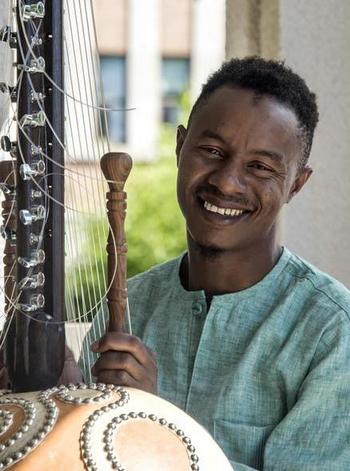 Kora player Diely Mori Tounkara, originally from Mali.
Kora player Diely Mori Tounkara, originally from Mali. Indeed, their ongoing success can be attributed to the winsome application of a effective formula: music, projected images and spoken-word narration, constructed around some kind of unifying theme.
In the first few multimedia productions, the themes Mackay chose often seemed suitable for infomercials emanating from some imagined “Ministry of Baroque Industry, Trade and Commerce.” Audiences learned, in much detail, about how telescopes, raisins, mirrors, linen, ink, candles, wire and coffee (among other things) were produced in Europe, back in the day.
This time, with Safe Haven – which I attended last Saturday (Jan. 20) – Mackay has further enlarged the purview of her ongoing series. She has taken up a subject with strong resonance in current-day Canada: the struggles of refugees, and the various adaptations they have made, over the centuries, to their host countries. To this end, she enlarged the musical resources of the Tafelmusik Orchestra with vocalist-narrator Maryem Tollar and percussionist Naghmeh Farahmand – two Toronto-based Middle-Eastern musicians who previously performed with Tafelmusik in Tales of Two Cities – and kora player Diely Mori Tounkara, who lives in Montreal.
The story of Safe Haven begins in 1685, when Louis XIV revoked the Edict of Nantes, driving Huguenots out of France and into neighbouring Protestant lands. Other refugees and displaced peoples are woven into the narrative, including Jews expelled from Spain, Scottish Catholics who went to Poland (who knew?) and the Roma (Gypsy) people, persecuted throughout Europe. In each instance, Mackay establishes how refugees enriched and enhanced their host communities.
For music, Tafelmusik offered up a smorgasbord of baroque repertoire, beginning with “Winter” from The Four Seasons, and including short pieces by Purcell, J.S. Bach, Telemann, Corelli, Albinoni and others. (Although some of Tafelmusik’s previous multimedia productions have required the musicians to play from memory while moving around the stage, here they sat and played from parts on their stands.)
The inclusion of the non-Western musicians emphasized the musical gifts that diasporic communities can bring to their host countries. Tollar and Farahmand acquitted themselves well, the former in songs in French and Ladino, and the latter in an extended solo on a drum called a daf (like a large tambourine minus the jangles). But it was Tounkara who stole the show, with his delicate and refined performance on the West African kora – a multi-stringed instrument that’s a cross between a lute and a harp.
The plight of refugees in recent times was never far from the surface of Safe Haven – and at times the topic was addressed explicitly. Canada’s current Haitian refugee “crisis” was touched upon. And Safe Haven concluded with images of the alarmingly small boat that brought 155 Tamil refugees to the coast of Newfoundland, 32 years ago.
By bringing up these Canadian examples, and by emphasizing the benefits that refugees can bring to their new homes, Safe Haven stepped into the realm of politics – something that classical concerts rarely do. But here, Mackay has taken a position that surely any right-thinking (or should I say left-thinking?), broadminded and generous Canadian would agree with: there’s no good reason not to welcome refugees.
© Colin Eatock 2018
 RSS Feed
RSS Feed

